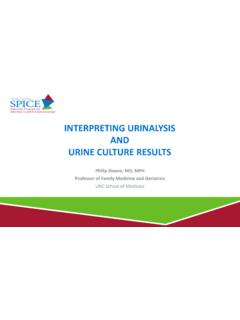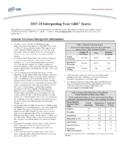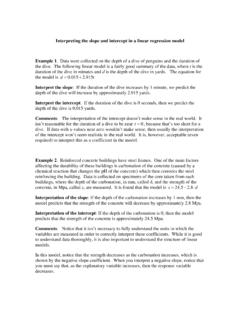Transcription of Interpreting Results of Case-Control Studies
1 Salmonella in the Caribbean - 2013 Interpreting Results of Case-Control Studies The odds ratio is the measure of association for a Case-Control study. It quantifies the relationship between an exposure (such as eating a food or attending an event) and a disease in a Case-Control study. The odds ratio is calculated using the number of case -patients who did or did not have exposure to a factor (such as a particular food) and the number of controls who did or did not have the exposure. The odds ratio tells us how much higher the odds of exposure are among case -patients than among controls.
2 An odds ratio of (or close to ) indicates that the odds of exposure among case -patients are the same as, or similar to, the odds of exposure among controls. The exposure is not associated with the disease. Greater than indicates that the odds of exposure among case -patients are greater than the odds of exposure among controls. The exposure might be a risk factor for the disease. Less than indicates that the odds of exposure among case -patients are lower than the odds of exposure among controls. The exposure might be a protective factor against the disease.
3 The magnitude of the odds ratio is called the strength of the association. The further away an odds ratio is from , the more likely it is that the relationship between the exposure and the disease is causal. For example, an odds ratio of is above , but is not a strong association. An odds ratio of 10 suggests a stronger association. Example In May 2005, the Kent County Health Department in Michigan was notified of an outbreak of vomiting and diarrhea following a company luncheon. Lunch included submarine sandwiches catered by a local restaurant.
4 An estimated 200 persons attended the luncheon; 55 attendees became ill. A Case-Control study was conducted. Fifty-three of 54 case -patients and 33 of 40 controls reported eating lettuce in their submarine sandwich. The odds ratio for lettuce was calculated to be How would you interpret the odds ratio? An odds ratio of means the odds of having eaten lettuce were 11 times higher among case -patients than controls. Because the odds ratio is greater than , lettuce might be a risk factor for illness after the luncheon.
5 The magnitude of the odds ratio suggests a strong association. Once the odds ratio is determined, tests of statistical significance must be used to determine the probability of finding an odds ratio as strong as or stronger than the one observed, if the exposure is not truly related to the disease ( , due to chance alone). This probability is called the p- value. The p-value is calculated using the same numbers that are used to calculate the odds ratio. The larger the p-value, the higher the probability that you might observe such an association as a result of chance alone and that the exposure is probably not related to the disease.
6 The smaller the p-value, the lower the probability that you might observe such an association as a result of chance alone and the greater the chance that the exposure is related to the disease. 2 Salmonella in the Caribbean - 2013 Interpreting Results of Case-Control Studies If the p-value is equal to or less than a predetermined cutoff (usually , or a 5 in 100 probability that the finding is due to chance alone), the association is said to be statistically significant. If it is greater than the predetermined cutoff, the association is said to be not statistically significant.
7 Example In the Kent County outbreak (described above), the p-value for the association between lettuce and illness is If the cutoff for statistical significance is , is the association between lettuce and illness statistically significant? A p- value of means that there is less than one chance in 100 that an odds ratio of at least would result by chance alone, if lettuce is not actually associated with illness. Because is less than the cutoff of , the finding is considered statistically significant. Source: Centers for Disease control and Prevention.
8 Multisite outbreak of norovirus associated with a franchise restaurant - -- Kent County, Michigan, May 2005. Morbidity and Mortality Weekly Report 2006;55(14);395-7. Readers should be aware that confidence intervals (i .e., the range of values for the measure of association that are consistent with the study findings) are used by some investigators to evaluate the role of chance in finding an odds ratio as strong or stronger than the one observed in a study. However, confidence intervals will not be discussed in this lesson.
9 Give it a try with the following exercise. EXERCISE On October 29, the North Carolina Division of Public Health (NCDPH) received a report of three cases of hemolytic uremic syndrome (HUS) among children caused by Escherichia coli O157:H7 infection. All three children visited a petting zoo at the North Carolina State Fair during October 15-24. case finding efforts by NCDPH identified 105 other persons who had become ill with diarrhea after attending the fair. A Case-Control study was undertaken to identify risk factors for infection with E.
10 Coli O157:H7. Forty-five case - patients and 188 controls who attended the fair and did not get sick were enrolled in the study. A p-value of was set as the cutoff for statistical significance. Thirty-six (80%) of 45 case -patients visited the petting zoo, compared with 64 (36%) of 187 controls (odds ratio = ; p< ). In an analysis of case -patients and controls who were aged <6 years who visited the petting zoo, the following Results were found: Exposure Odds ratio p-value Touching or stepping in manure Falling or sitting on the ground Use of a pacifier or spill-proof cup or sucking on one s thumb while at the zoo Use of alcohol-based hand sanitizer Awareness of risk of disease from contact with livestock* *among parents who accompanied the children 3 Salmonella in the Caribbean - 2013 Interpreting Results of Case-Control Studies QUESTION 1.

















